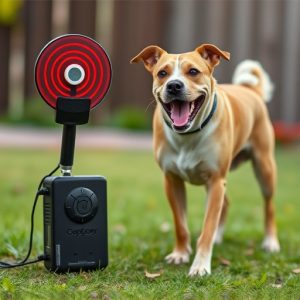Electronic Dog Repellent: Safety Standards & Effective Implementation Guide
Animal control sonic repellents use high-frequency acoustic signals to deter wildlife without affect…….
Animal control sonic repellents use high-frequency acoustic signals to deter wildlife without affecting humans or other non-target species, promoting peaceful coexistence. In electronic dog repellents, safety is paramount, with devices utilizing sound wave or ultrasonic technology under strict Electronic Dog Repellent Safety Standards and Certification from recognized labs. These ensure inaudible or minimally audible sounds to humans while effectively deterring dogs, upholding ethical animal control practices. Effective implementation requires strategic planning, regular maintenance, calibration, and area inspections for optimal performance.
“Discover the revolutionary power of animal control sonic repellent systems, a non-lethal and eco-friendly approach to deterring unwanted critters. This article explores how these electronic dog repellents work, delving into the science behind sound waves and their impact on animals. We’ll also dissect the importance of Electronic Dog Repellent Safety Standards and Certifications, ensuring your chosen system is both effective and secure. Learn practical tips for implementing and maintaining these systems to create a harmonious environment.”
- Understanding Animal Control Sonic Repellents: How They Work
- Electronic Dog Repellent Safety Standards and Certifications
- Implementing and Maintaining a Sonic Repellent System Effectively
Understanding Animal Control Sonic Repellents: How They Work
Animal control sonic repellents are innovative devices designed to deter animals from specific areas using sound waves. Unlike traditional electronic dog repellents, these systems emit high-frequency acoustic signals that are inaudible to humans but can effectively drive away wildlife like cats, raccoons, and squirrels. The technology is based on creating an unpleasant sensory experience for the target animals, making them avoid the treated area.
These devices operate under strict safety standards and often undergo rigorous testing to ensure they pose no harm to non-target species or humans. Reputable manufacturers adhere to certification processes, such as those provided by international regulatory bodies, guaranteeing their products’ effectiveness and safety. This includes protection against over-exposure to the sound waves, ensuring that both domestic pets and wildlife can coexist peacefully in shared spaces.
Electronic Dog Repellent Safety Standards and Certifications
When it comes to electronic dog repellents, ensuring safety is paramount. These devices use sound waves or ultrasonic technology to deter dogs from specific areas, making them popular for both residential and commercial purposes. Reputable manufacturers adhere to strict Electronic Dog Repellent Safety Standards and obtain Certifications to guarantee their products’ effectiveness and safety for both pets and humans.
Certifications, such as those from recognized testing laboratories, confirm that the repellents meet specific criteria for sound pressure levels, ensuring they are inaudible or minimally audible to humans while effectively reaching dogs. This balance ensures that the devices are humane and do not cause harm or distress, upholding ethical standards in animal control practices.
Implementing and Maintaining a Sonic Repellent System Effectively
Implementing an electronic dog repellent system effectively requires careful planning and adherence to safety standards. It’s crucial to choose a device that has been certified by recognised authorities, ensuring it operates within safe sound pressure levels to avoid harm to both animals and humans. Placement is key; strategically position the devices in areas where unwanted canine intrusion occurs, considering factors like wind direction and terrain to maximise coverage. Regular maintenance is essential for optimal performance. This includes checking battery life, cleaning sensors, and ensuring the device is free from damage. Additionally, monitoring environmental conditions such as temperature and humidity can help prolong the system’s lifespan.
To maintain effectiveness, it’s important to calibrate the system periodically according to manufacturer recommendations. Keep records of usage and any adjustments made for future reference. Regularly inspect surrounding areas for potential obstacles that could impede signal transmission. If necessary, adjust the device settings or consider additional units to enhance coverage. By following these steps, you can ensure an electronic dog repellent system is not only installed correctly but also remains a reliable solution for keeping unwanted dogs at bay.
Animal control sonic repellents offer a non-lethal, humane solution for managing problematic wildlife. By understanding their mechanism of action and implementing best practices for safety and maintenance, as highlighted by Electronic Dog Repellent Safety Standards and Certifications, these systems can effectively deter animals without causing harm. With proper use, sonic repellents can transform spaces into havens free from unwanted visitors, ensuring peace of mind for residents.


